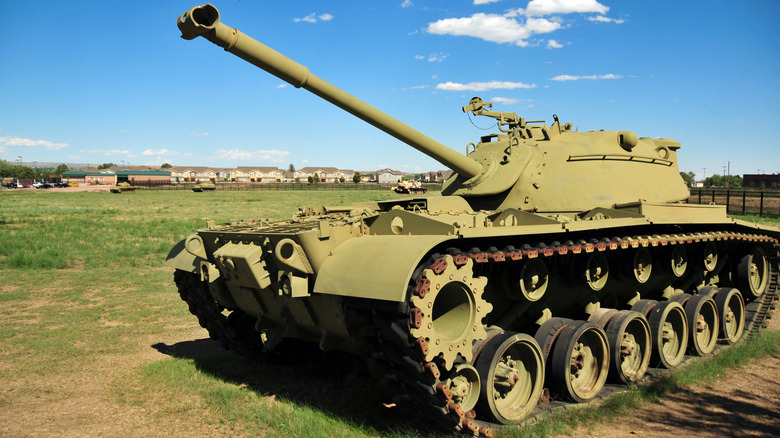
M48 Patton tank
Few American generals have left such an indelible mark on military history as George S. Patton. “Old Blood and Guts,” as he was affectionately known due to his matter-of-fact and typically exuberant speeches, was a West Point graduate who was a veteran of the two World Wars.
In World War I, Patton served as a cavalry officer before becoming the first member of the U.S. Tank Force in 1917. In 1942, as a major general, Patton commanded the I Armored Corps in the Allied campaign in North Africa. He was promoted to lieutenant general in 1943 and led the Third United States Army to victory in the European Theater of World War II.
Both these World War II campaigns relied heavily on the use of tanks, and Patton is most closely associated with commanding front-line ground combat with these armored rolling fortresses. He died in an accident some months after the end of World War II while stationed in Germany. However, his legacy lives on in the annals of military history and the series of tanks that bore his name.
Development Of The M46 Patton
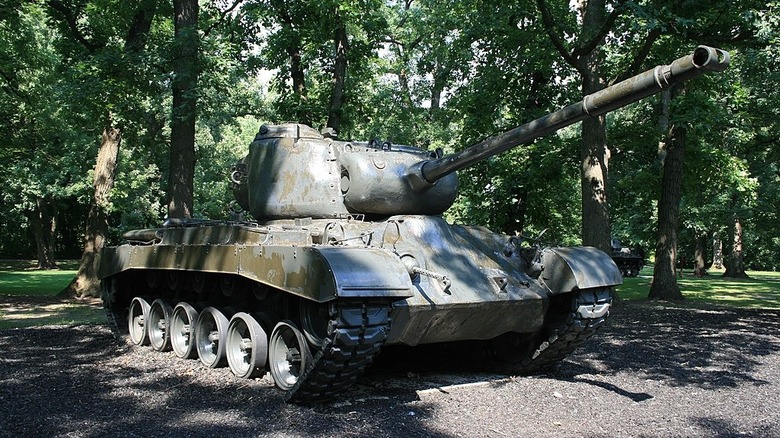
M46 Patton Tank
The first Patton tank was a post-World War II upgrade to the M26 Pershing heavy tank. The Pershing was conceived as a response to the German Tiger tank, which outclassed the U.S. Army’s primary M4 Sherman model in battle with heavier armor and superior weaponry. While the Pershing had improved firepower, it lacked maneuverability compared to the Shermans. A newly modified tank was created to address this issue, and it was to be named the M46 Patton after the recently deceased general.
The Detroit Tank Arsenal manufactured the new M46 Patton medium tank as an upgrade to the Pershing medium tank. Its weaponry remained the same as that of the M26 Pershing, comprising an M3A1 90-millimeter main gun with an additional .50-caliber and two .30-caliber machine guns. It had a more potent Continental V12 engine that produced 704 horsepower. Mobility was then improved by adding a cross-drive transmission, which enabled pivot-steering. Additionally, the M46 had better braking, upgraded electronics, a higher gear ratio, a reconfigured exhaust, and more efficient engine cooling. It was crewed by five soldiers, consisting of a commander, gunner, loader, and two drivers (one on either side).
[Featured image by Gary Todd from Xinzheng, China via
.jpg)
The M46 Patton Tank In Service
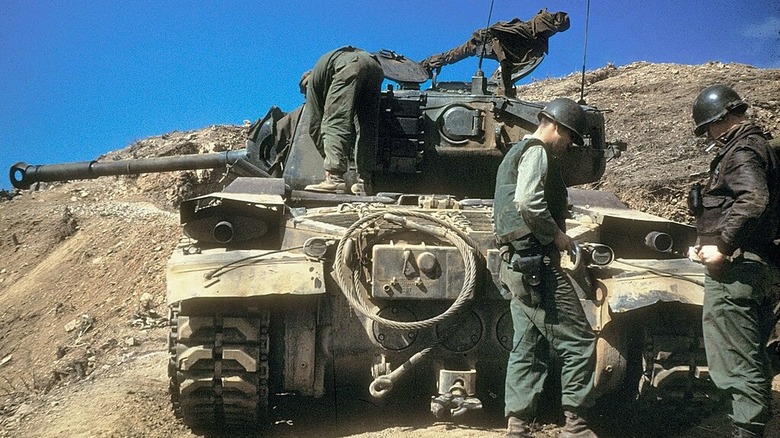
M46 Patton Tank
The new M46 model was named in George S. Patton’s honor during production in 1948. Subsequently, approximately 800 M26 Pershings were upgraded to the M46 Patton, and the first units entered service a year later. Soon, in 1950, the M46 was to see its first action during the Korean War, where around 200 units were matched against the Russian T-34 tanks of the North Korean Army.
While it featured relatively old technology, the T-34 had proved to be a formidable fighting machine on the Eastern Front in World War II. Yet, the new M46 Patton proved to be a worthy match on the battlefield, although veteran Sherman and Pershing models made up the vast majority of the tank force in its first year.
The Korean War was the only conflict featuring the M46 Patton tank. However, its performance was impressive enough to supersede the Pershing and Sherman units later. It was even kept in service while its successor, the M47, underwent improvements to rectify recurring issues, as it demonstrated proven reliability as an upgrade to the tried-and-tested Pershing that came before it.
[Featured image public domain via
.jpg)
Development Of The M47 Patton
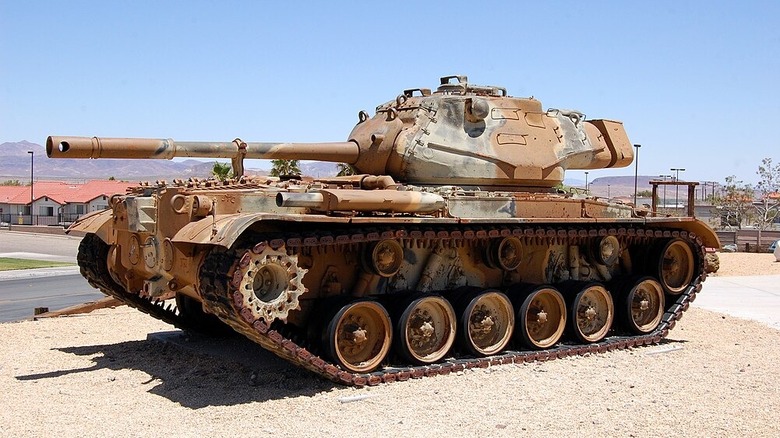
M47 Patton tank
As the Cold War solidified and gathered intensity, the United States knew it had to improve its armament to secure its standing among world superpowers and to counter the Soviet threat. Its tank force required an overhaul, and the M46 Patton, with its roots in World War II technology, was to be upgraded. This overhaul was especially vital, as the improved machine would compete with the superior Soviet IS-2 heavy tank, with its 122-millimeter guns and 110-millimeter armor plating.
The M47 Patton still had much in common with its predecessor, the M46, including the same 90-millimeter cannon and machine gun configuration and a Continental 12-cylinder engine with a similar power output. Its slimmer turret, more acute hull design, and upgraded rangefinder were notable differences, although the latter took longer in production and wasn’t installed on earlier models. During production, the United States changed its designation of tanks based on their gun caliber. Therefore, from 1950 onwards, the M47 Patton medium tank was called a 90-millimeter gun tank.
[Featured image by Epolk via Wikimedia Commons | Cropped and scaled | CC BY-SA 3.0]
The M47 Patton Tank In Service
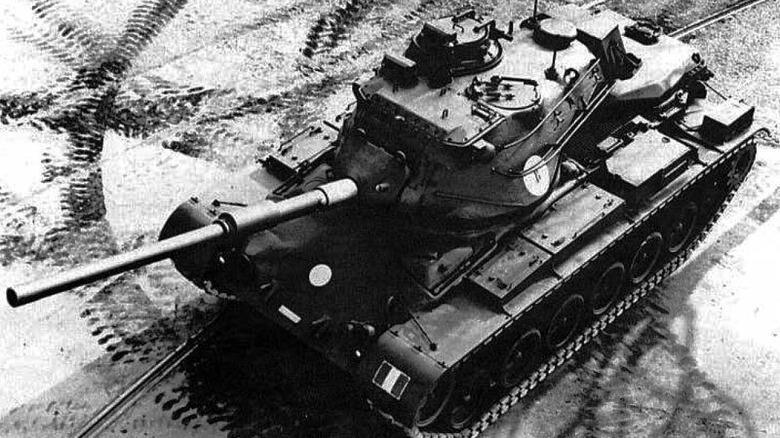
M47 Patton tank
Unfortunately, the rushed M47 project stalled as the new Patton tank started showing issues after entering service in 1951. The M47 should have been a marked improvement on its predecessor, as a significant upgrade was needed in the face of Russian superiority. However, both the M46 and Pershing units were kept in service as the problems with the M47 were addressed, and it was increasingly apparent that a greater evolutionary step needed to be made if the United States were to compete with its armored power division.
The M47 has the distinction of being the only Patton series tank that never saw active service with the United States. It did receive further upgrades in the 1960s, and several hundred of these modified units were used by the armies of Pakistan and Iran. During its first year of service, the United States military was already working on the successor to the flawed M47, and as early as 1952, the new tank was rolling off the production line.
[Featured image public domain via

Development Of The M48 Patton

M48 Patton Tank
The M48 Patton marked a significant step in the evolution of the series, and was to be the most successful Patton tank so far. Like the M47, it also suffered teething problems, but these were justifiable, given its numerous innovations and improvements. They included an engine overhaul and a more powerful main cannon, a single central driver position, and a yoke that replaced the previous lever-based steering system. Composite materials, which offered better protection, were applied to the armor, and a more advanced fire control system combined an improved rangefinder with a ballistic computer that calculated the optimum firing solution.
With no requirement for an assistant driver, the M48 Patton had one fewer crew member and one fewer machine gun than its predecessors, comprising a 90-millimeter main gun and single .50-caliber and .30-caliber machine guns. It measured over 30 feet in length by 12 feet wide and was over 10 feet in height. Its armor plating was thicker than the M47’s at 110 millimeters, and at almost 50 tons in weight, it could muster speeds of up to 30 miles per hour. Initially, the M48’s range was just 70 miles, until the addition of external fuel tanks mounted at the rear gave it a maximum range of 135 miles.
Three more variants were made: the M48A1, M48A2, and M48A3, each with various improvements on the last. Chrysler was initially awarded the contract, with a production target of 3,000 units per year over three years. However, complications with the transmission, engine, and suspension slowed progress. Eventually, around 12,000 M48 variants were built throughout its production run, with Ford, General Motors, and the Fisher Tank Arsenal also joining in its manufacture.
[Featured image by Arcticseahorse via

The M48 Patton Tank In Service
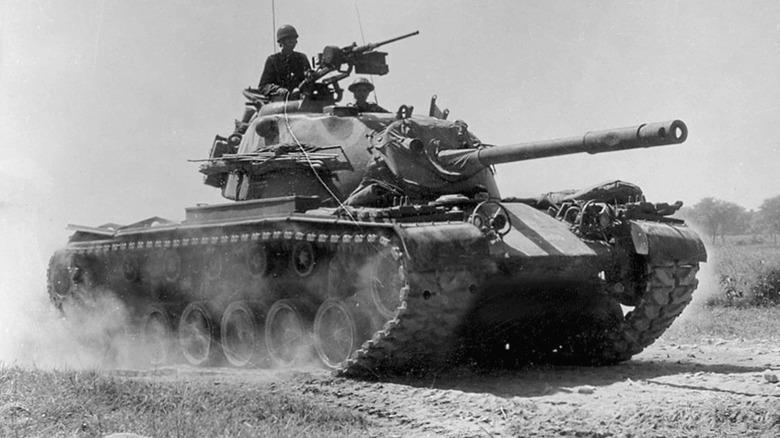
M48 Patton tank
The Cold War escalated during the Berlin Crisis in 1961, as the Soviet Union’s Premier Nikita Kruschev demanded that Western Allies withdraw their forces from West Berlin. Here, United States M48 tanks faced off against Soviet T-34s in a tense exchange on either side of Checkpoint Charlie before the matter was peacefully resolved.
The next time Patton tanks saw action was during the Vietnam War, as the M48A3 became the most widely-used American tank. From 1965, over 600 units of the M48 were shipped to Vietnam, where they performed various duties. Many were equipped with flamethrowers, white phosphorus, and canister rounds. There were instances where the M48 was called upon to face North Vietnamese forces in tanks, but most duties were in support of infantry on the ground.
The M48 was used by many of the United States’ allies, most notably Israel, in the Six-Day War where, once again, they were pitted against Soviet tanks, this time occupied by the Egyptian and Syrian armies. By 1973, after participating in many international conflicts, the M48 was mostly taken out of service, having been succeeded by the M60.
[Featured image public domain via

Development Of The M60 Main Battle Tank

M60 Main Battle Tank
The M60 was never officially christened a Patton tank. Still, it is widely considered the last in the Patton series and a continuation of the lineage. Specifically, it was based upon the M48A2, with which it had much in common. It was distinguished by its sloping hull, lighter aluminum wheels and, most importantly, its more powerful 105-millimeter gun. Despite the extra firepower, the tank was around 3,000 pounds lighter than its predecessor and featured a less potent but more economical 643 horsepower diesel engine compared to the earlier Patton tanks’ gas-powered engines. It first appeared in late 1960 and bore the designation of “105-millimeter gun tank.”
Like other Patton tanks before it, the M60 would be upgraded with several variants. These included the M60A1 in 1962, with a redesigned turret, improved armor, better ergonomics, and hydraulic controls. The M60A1, in turn, would receive upgrades to the engine, better electronics, infrared searchlights, night vision periscopes, and various weapons, including smoke grenades. This was followed in 1973 by the M60A2, 152-millimeter gun launcher tank, with a larger cannon that launched the Shillelagh missile 3,300 yards and the HEAT-MP round for close-range targets. Finally, in 1979, the M60A3 was launched, based on the M60A1, with the same 105-millimeter M68 gun but with up-to-date equipment, including a ballistic computer, laser rangefinder, and a crosswind sensor.
The M60 Main Battle Tank In Service
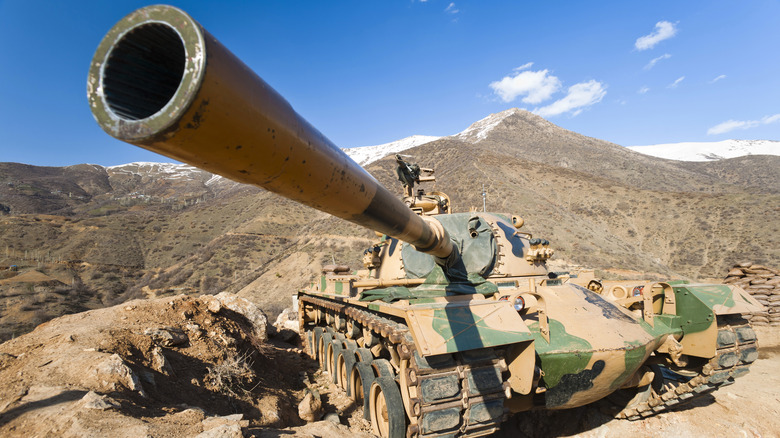
M60 Main Battle Tank
The M60 traces its history to a single event during the Hungarian Revolution of 1956. The British captured a Soviet T54-A tank that rolled into its embassy and, upon inspection, found it to be vastly superior to any of the Western Allies’ machines. The coalition utilized this as the benchmark for future tanks, and the United States used it when upgrading the M48 to the M60, with its 105-millimeter main gun and improved armor.
The M60 subsequently became a mainstay of U.S. defenses during the Cold War years. It was a formidable machine that could fire seven rounds per minute, and it proved its value in the Yom Kippur War of 1973, the Iran-Iraq War of 1982, the Lebanon War of 1982, and the first Gulf War of 1991. In the latter conflict, during a battle at Kuwait Airport, the M60 performed impressively, obliterating several Iraqi tanks while only losing a single unit to its Soviet-built counterparts. The M60 was retired by the U.S. soon after the Gulf War and replaced by the M1 Abrams tank, although exports are still in service in several countries across Europe, South America, Asia, and the Middle East.
The Successor To The Patton Tanks
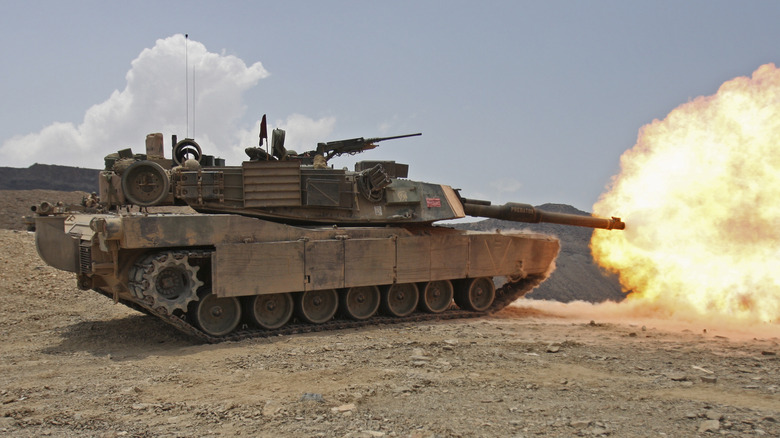
M1 Abrams Tank
By the mid-1970s, it was clear that the United States tank force was in need of an update, especially when pitted against the notorious Russian T-72. By 1980, production of the new tank, the M1 Abrams 105-millimeter gun tank, was complete. It featured improved composite armor, a ballistic computer, day sight and thermal imaging, and a laser rangefinder. The Tank Commander also had a sight extension to view where the gunner was aiming. While similar in size, it was a full 20,000 pounds heavier than the M60 and used the same 105-millimeter cannon and four-person crew configuration.
By 1985, the M1 Abrams had been upgraded to the M1A1, with a 120-millimeter main gun equal in size to that of Germany’s Leopard 2 tank. This was further improved five years later as the M1A2 Abrams, the variant still in use today. It is considered the most advanced battle tank in existence, and has been regularly upgraded since 1990 to keep up with technological developments. The modern Abrams tank has unsurpassed accuracy, communications, dual thermal viewers, and digital displays with associated technology.
While the M1A2 Abrams is one of the best tanks ever made, there have been clear milestones in tank technology evolution since World War I, which accelerated after the introduction of the M46 Patton shortly after World War II. It was a trailblazing dynasty that helped define the United States Army’s power and technology at one of the most politically turbulent times in recent history.
Read the original article on SlashGear.
News Related-
Russian court extends detention of Wall Street Journal reporter Gershkovich until end of January
-
Russian court extends detention of Wall Street Journal reporter Evan Gershkovich, arrested on espionage charges
-
Israel's economy recovered from previous wars with Hamas, but this one might go longer, hit harder
-
Stock market today: Asian shares mixed ahead of US consumer confidence and price data
-
EXCLUSIVE: ‘Sister Wives' star Christine Brown says her kids' happy marriages inspired her leave Kody Brown
-
NBA fans roast Clippers for losing to Nuggets without Jokic, Murray, Gordon
-
Panthers-Senators brawl ends in 10-minute penalty for all players on ice
-
CNBC Daily Open: Is record Black Friday sales spike a false dawn?
-
Freed Israeli hostage describes deteriorating conditions while being held by Hamas
-
High stakes and glitz mark the vote in Paris for the 2030 World Expo host
-
Biden’s unworkable nursing rule will harm seniors
-
Jalen Hurts: We did what we needed to do when it mattered the most
-
LeBron James takes NBA all-time minutes lead in career-worst loss
-
Vikings' Kevin O'Connell to evaluate Josh Dobbs, path forward at QB
